Literature Review: Meeting Needs of Dyslexic Nurses in Programs
VerifiedAdded on 2023/06/18
|8
|1716
|481
Literature Review
AI Summary
This literature review examines the challenges faced by nurses with dyslexia within registered nursing programs and identifies gaps in current knowledge and support systems. It begins by defining dyslexia and its impact on learning, particularly in the context of nursing. The review highlights the limited research on dyslexia among registered nurses, despite evidence suggesting a significant presence. It explores the perceived stigma, lack of understanding, and emotional challenges faced by dyslexic nurses, including lower self-esteem and difficulties in accessing support. The review critically analyzes existing studies, noting the variability in lecturer support and the need for inclusive teaching and assessment approaches. It concludes by emphasizing the gap in research concerning how registered nursing programs can be modified to better meet the needs of nurses with dyslexia, proposing a research question focused on filling the gaps within theoretical learning to address these needs. Desklib offers a variety of study tools and resources to support students in healthcare and related fields.
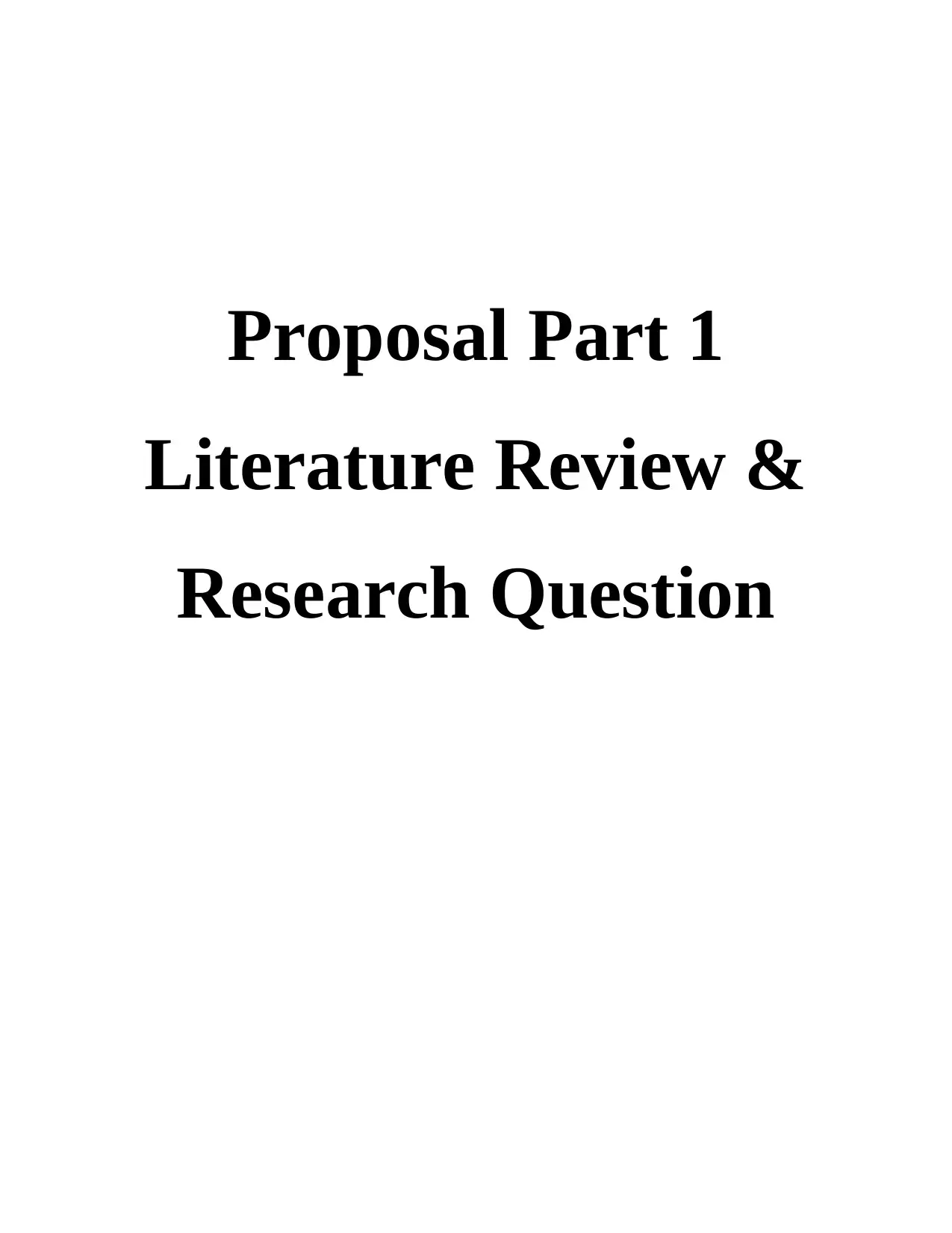
Proposal Part 1
Literature Review &
Research Question
Literature Review &
Research Question
Paraphrase This Document
Need a fresh take? Get an instant paraphrase of this document with our AI Paraphraser
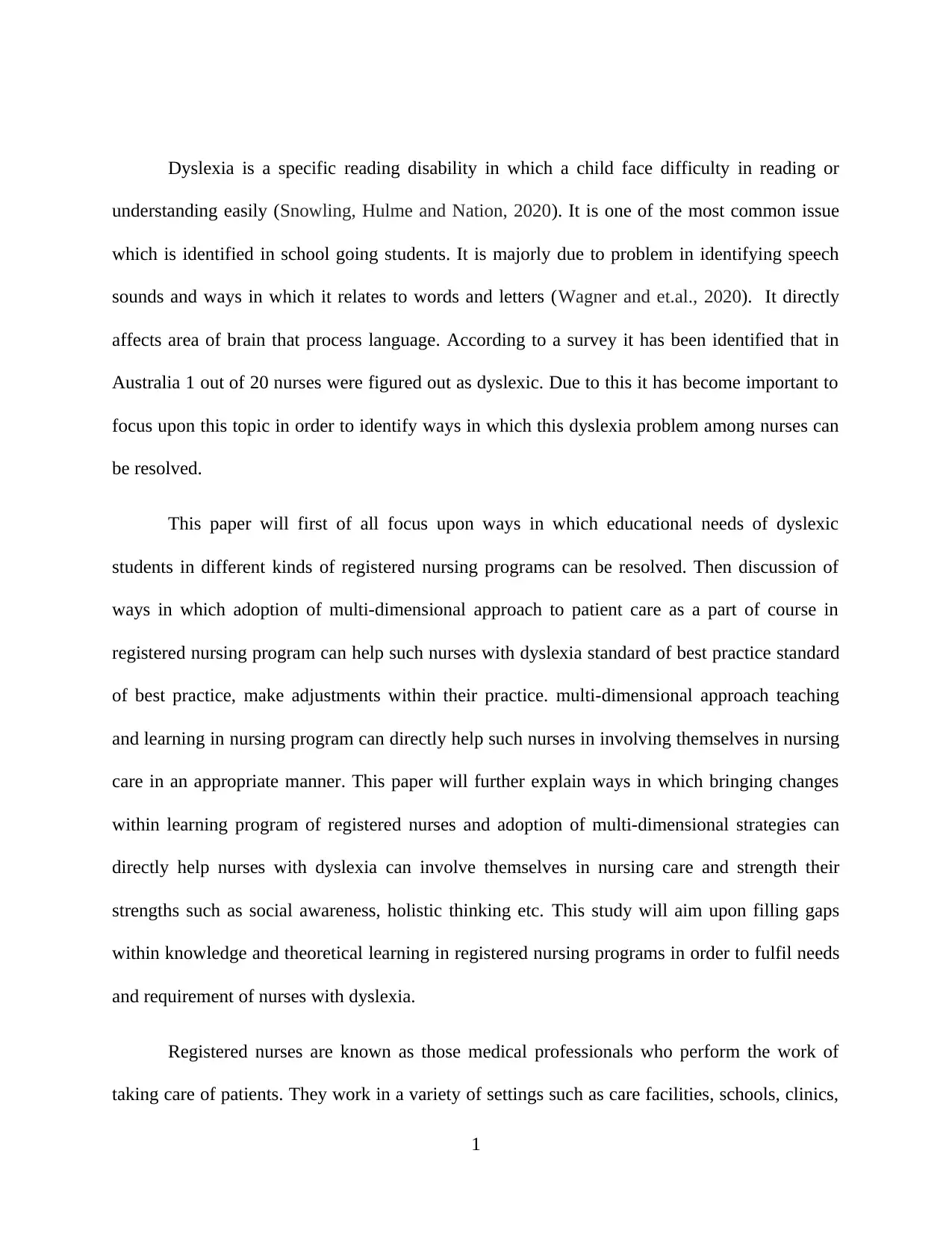
Dyslexia is a specific reading disability in which a child face difficulty in reading or
understanding easily (Snowling, Hulme and Nation, 2020). It is one of the most common issue
which is identified in school going students. It is majorly due to problem in identifying speech
sounds and ways in which it relates to words and letters (Wagner and et.al., 2020). It directly
affects area of brain that process language. According to a survey it has been identified that in
Australia 1 out of 20 nurses were figured out as dyslexic. Due to this it has become important to
focus upon this topic in order to identify ways in which this dyslexia problem among nurses can
be resolved.
This paper will first of all focus upon ways in which educational needs of dyslexic
students in different kinds of registered nursing programs can be resolved. Then discussion of
ways in which adoption of multi-dimensional approach to patient care as a part of course in
registered nursing program can help such nurses with dyslexia standard of best practice standard
of best practice, make adjustments within their practice. multi-dimensional approach teaching
and learning in nursing program can directly help such nurses in involving themselves in nursing
care in an appropriate manner. This paper will further explain ways in which bringing changes
within learning program of registered nurses and adoption of multi-dimensional strategies can
directly help nurses with dyslexia can involve themselves in nursing care and strength their
strengths such as social awareness, holistic thinking etc. This study will aim upon filling gaps
within knowledge and theoretical learning in registered nursing programs in order to fulfil needs
and requirement of nurses with dyslexia.
Registered nurses are known as those medical professionals who perform the work of
taking care of patients. They work in a variety of settings such as care facilities, schools, clinics,
1
understanding easily (Snowling, Hulme and Nation, 2020). It is one of the most common issue
which is identified in school going students. It is majorly due to problem in identifying speech
sounds and ways in which it relates to words and letters (Wagner and et.al., 2020). It directly
affects area of brain that process language. According to a survey it has been identified that in
Australia 1 out of 20 nurses were figured out as dyslexic. Due to this it has become important to
focus upon this topic in order to identify ways in which this dyslexia problem among nurses can
be resolved.
This paper will first of all focus upon ways in which educational needs of dyslexic
students in different kinds of registered nursing programs can be resolved. Then discussion of
ways in which adoption of multi-dimensional approach to patient care as a part of course in
registered nursing program can help such nurses with dyslexia standard of best practice standard
of best practice, make adjustments within their practice. multi-dimensional approach teaching
and learning in nursing program can directly help such nurses in involving themselves in nursing
care in an appropriate manner. This paper will further explain ways in which bringing changes
within learning program of registered nurses and adoption of multi-dimensional strategies can
directly help nurses with dyslexia can involve themselves in nursing care and strength their
strengths such as social awareness, holistic thinking etc. This study will aim upon filling gaps
within knowledge and theoretical learning in registered nursing programs in order to fulfil needs
and requirement of nurses with dyslexia.
Registered nurses are known as those medical professionals who perform the work of
taking care of patients. They work in a variety of settings such as care facilities, schools, clinics,
1
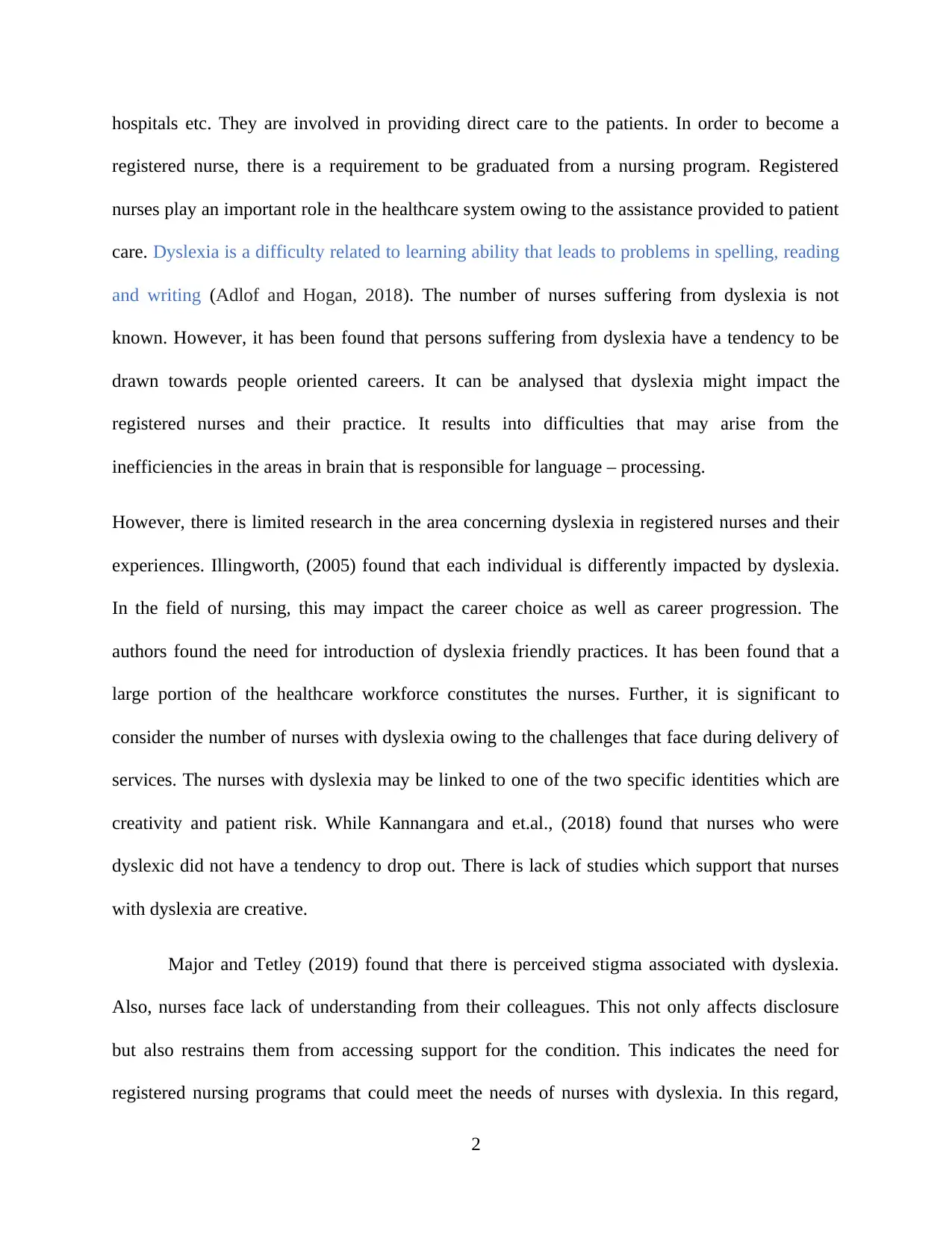
hospitals etc. They are involved in providing direct care to the patients. In order to become a
registered nurse, there is a requirement to be graduated from a nursing program. Registered
nurses play an important role in the healthcare system owing to the assistance provided to patient
care. Dyslexia is a difficulty related to learning ability that leads to problems in spelling, reading
and writing (Adlof and Hogan, 2018). The number of nurses suffering from dyslexia is not
known. However, it has been found that persons suffering from dyslexia have a tendency to be
drawn towards people oriented careers. It can be analysed that dyslexia might impact the
registered nurses and their practice. It results into difficulties that may arise from the
inefficiencies in the areas in brain that is responsible for language – processing.
However, there is limited research in the area concerning dyslexia in registered nurses and their
experiences. Illingworth, (2005) found that each individual is differently impacted by dyslexia.
In the field of nursing, this may impact the career choice as well as career progression. The
authors found the need for introduction of dyslexia friendly practices. It has been found that a
large portion of the healthcare workforce constitutes the nurses. Further, it is significant to
consider the number of nurses with dyslexia owing to the challenges that face during delivery of
services. The nurses with dyslexia may be linked to one of the two specific identities which are
creativity and patient risk. While Kannangara and et.al., (2018) found that nurses who were
dyslexic did not have a tendency to drop out. There is lack of studies which support that nurses
with dyslexia are creative.
Major and Tetley (2019) found that there is perceived stigma associated with dyslexia.
Also, nurses face lack of understanding from their colleagues. This not only affects disclosure
but also restrains them from accessing support for the condition. This indicates the need for
registered nursing programs that could meet the needs of nurses with dyslexia. In this regard,
2
registered nurse, there is a requirement to be graduated from a nursing program. Registered
nurses play an important role in the healthcare system owing to the assistance provided to patient
care. Dyslexia is a difficulty related to learning ability that leads to problems in spelling, reading
and writing (Adlof and Hogan, 2018). The number of nurses suffering from dyslexia is not
known. However, it has been found that persons suffering from dyslexia have a tendency to be
drawn towards people oriented careers. It can be analysed that dyslexia might impact the
registered nurses and their practice. It results into difficulties that may arise from the
inefficiencies in the areas in brain that is responsible for language – processing.
However, there is limited research in the area concerning dyslexia in registered nurses and their
experiences. Illingworth, (2005) found that each individual is differently impacted by dyslexia.
In the field of nursing, this may impact the career choice as well as career progression. The
authors found the need for introduction of dyslexia friendly practices. It has been found that a
large portion of the healthcare workforce constitutes the nurses. Further, it is significant to
consider the number of nurses with dyslexia owing to the challenges that face during delivery of
services. The nurses with dyslexia may be linked to one of the two specific identities which are
creativity and patient risk. While Kannangara and et.al., (2018) found that nurses who were
dyslexic did not have a tendency to drop out. There is lack of studies which support that nurses
with dyslexia are creative.
Major and Tetley (2019) found that there is perceived stigma associated with dyslexia.
Also, nurses face lack of understanding from their colleagues. This not only affects disclosure
but also restrains them from accessing support for the condition. This indicates the need for
registered nursing programs that could meet the needs of nurses with dyslexia. In this regard,
2
⊘ This is a preview!⊘
Do you want full access?
Subscribe today to unlock all pages.

Trusted by 1+ million students worldwide
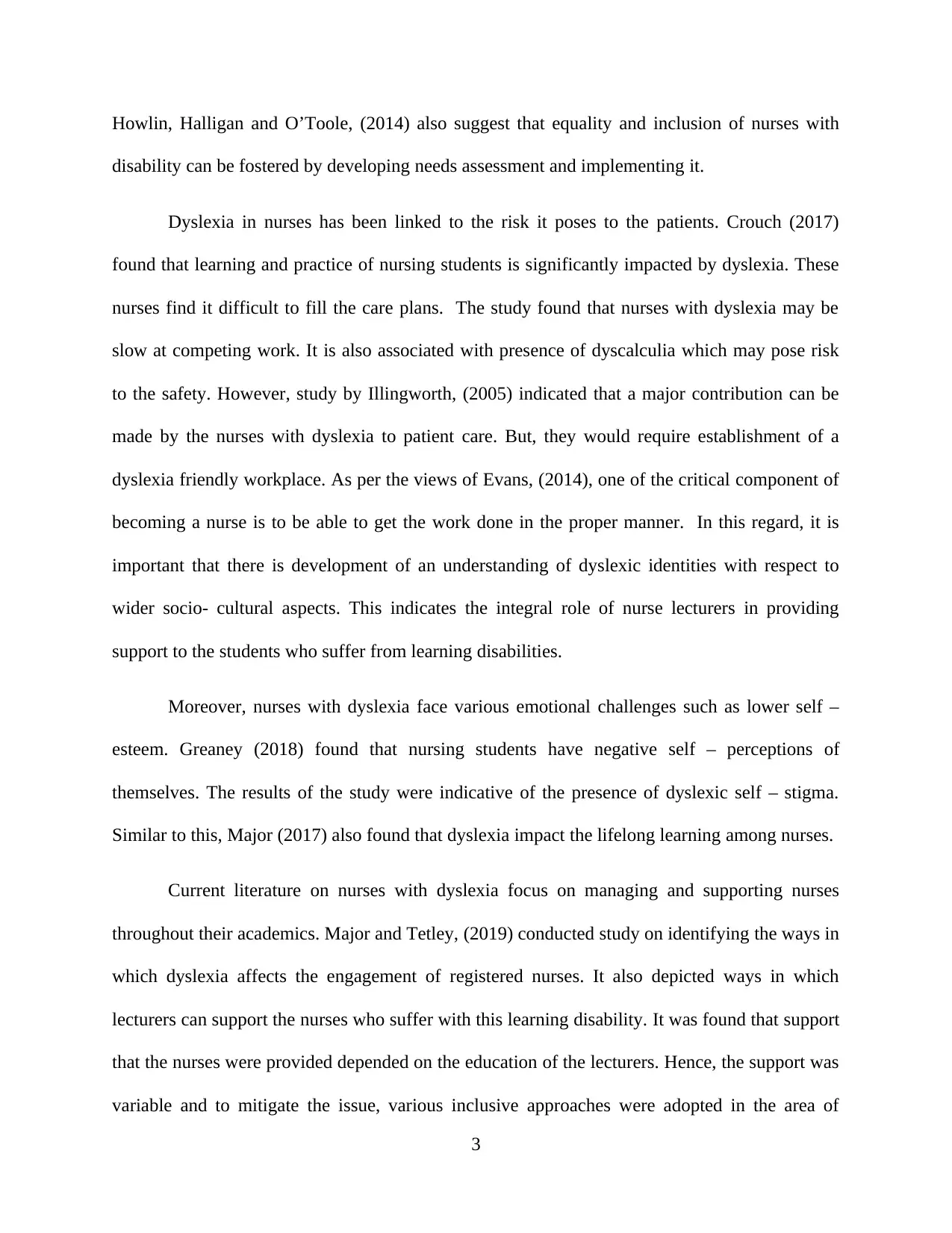
Howlin, Halligan and O’Toole, (2014) also suggest that equality and inclusion of nurses with
disability can be fostered by developing needs assessment and implementing it.
Dyslexia in nurses has been linked to the risk it poses to the patients. Crouch (2017)
found that learning and practice of nursing students is significantly impacted by dyslexia. These
nurses find it difficult to fill the care plans. The study found that nurses with dyslexia may be
slow at competing work. It is also associated with presence of dyscalculia which may pose risk
to the safety. However, study by Illingworth, (2005) indicated that a major contribution can be
made by the nurses with dyslexia to patient care. But, they would require establishment of a
dyslexia friendly workplace. As per the views of Evans, (2014), one of the critical component of
becoming a nurse is to be able to get the work done in the proper manner. In this regard, it is
important that there is development of an understanding of dyslexic identities with respect to
wider socio- cultural aspects. This indicates the integral role of nurse lecturers in providing
support to the students who suffer from learning disabilities.
Moreover, nurses with dyslexia face various emotional challenges such as lower self –
esteem. Greaney (2018) found that nursing students have negative self – perceptions of
themselves. The results of the study were indicative of the presence of dyslexic self – stigma.
Similar to this, Major (2017) also found that dyslexia impact the lifelong learning among nurses.
Current literature on nurses with dyslexia focus on managing and supporting nurses
throughout their academics. Major and Tetley, (2019) conducted study on identifying the ways in
which dyslexia affects the engagement of registered nurses. It also depicted ways in which
lecturers can support the nurses who suffer with this learning disability. It was found that support
that the nurses were provided depended on the education of the lecturers. Hence, the support was
variable and to mitigate the issue, various inclusive approaches were adopted in the area of
3
disability can be fostered by developing needs assessment and implementing it.
Dyslexia in nurses has been linked to the risk it poses to the patients. Crouch (2017)
found that learning and practice of nursing students is significantly impacted by dyslexia. These
nurses find it difficult to fill the care plans. The study found that nurses with dyslexia may be
slow at competing work. It is also associated with presence of dyscalculia which may pose risk
to the safety. However, study by Illingworth, (2005) indicated that a major contribution can be
made by the nurses with dyslexia to patient care. But, they would require establishment of a
dyslexia friendly workplace. As per the views of Evans, (2014), one of the critical component of
becoming a nurse is to be able to get the work done in the proper manner. In this regard, it is
important that there is development of an understanding of dyslexic identities with respect to
wider socio- cultural aspects. This indicates the integral role of nurse lecturers in providing
support to the students who suffer from learning disabilities.
Moreover, nurses with dyslexia face various emotional challenges such as lower self –
esteem. Greaney (2018) found that nursing students have negative self – perceptions of
themselves. The results of the study were indicative of the presence of dyslexic self – stigma.
Similar to this, Major (2017) also found that dyslexia impact the lifelong learning among nurses.
Current literature on nurses with dyslexia focus on managing and supporting nurses
throughout their academics. Major and Tetley, (2019) conducted study on identifying the ways in
which dyslexia affects the engagement of registered nurses. It also depicted ways in which
lecturers can support the nurses who suffer with this learning disability. It was found that support
that the nurses were provided depended on the education of the lecturers. Hence, the support was
variable and to mitigate the issue, various inclusive approaches were adopted in the area of
3
Paraphrase This Document
Need a fresh take? Get an instant paraphrase of this document with our AI Paraphraser
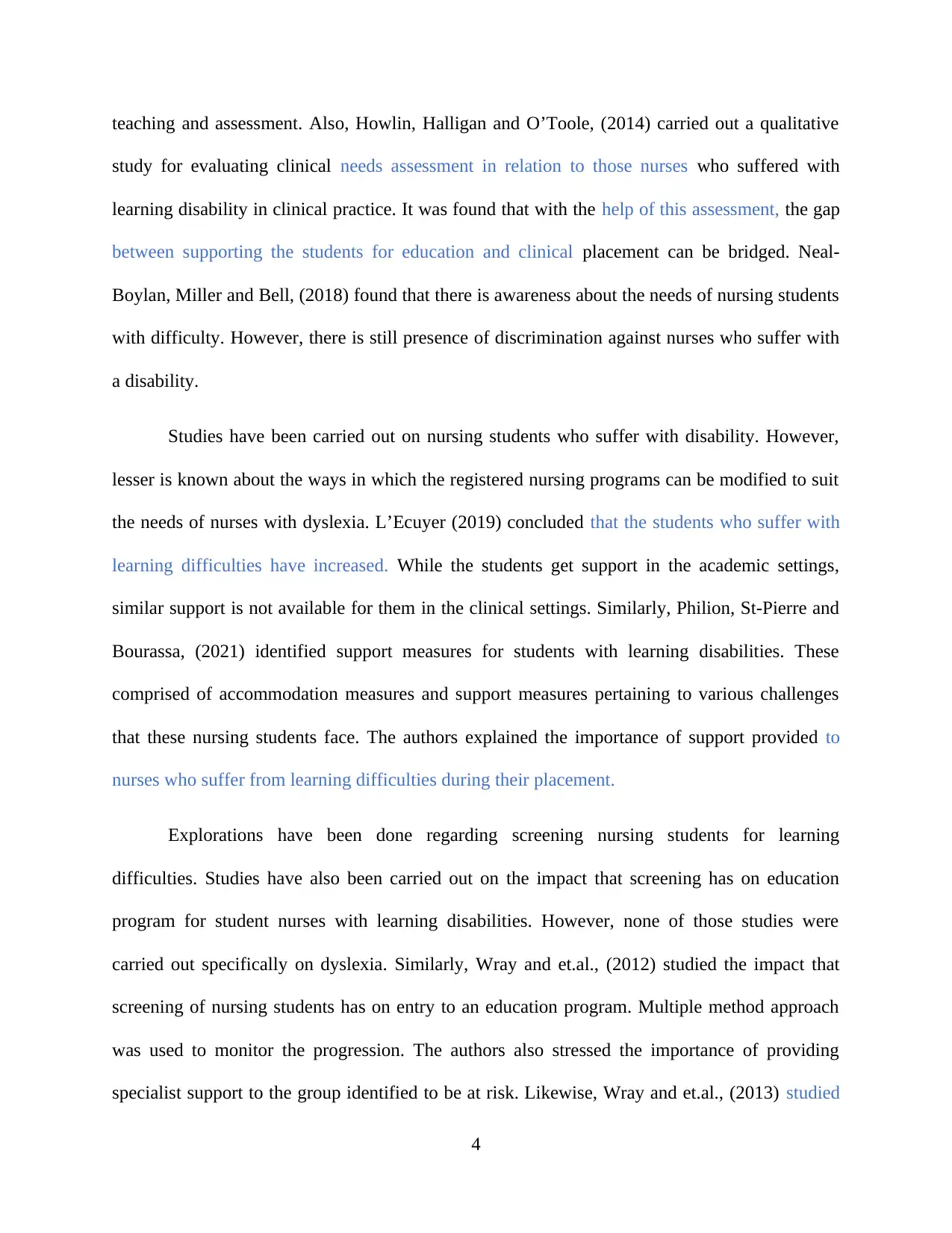
teaching and assessment. Also, Howlin, Halligan and O’Toole, (2014) carried out a qualitative
study for evaluating clinical needs assessment in relation to those nurses who suffered with
learning disability in clinical practice. It was found that with the help of this assessment, the gap
between supporting the students for education and clinical placement can be bridged. Neal-
Boylan, Miller and Bell, (2018) found that there is awareness about the needs of nursing students
with difficulty. However, there is still presence of discrimination against nurses who suffer with
a disability.
Studies have been carried out on nursing students who suffer with disability. However,
lesser is known about the ways in which the registered nursing programs can be modified to suit
the needs of nurses with dyslexia. L’Ecuyer (2019) concluded that the students who suffer with
learning difficulties have increased. While the students get support in the academic settings,
similar support is not available for them in the clinical settings. Similarly, Philion, St-Pierre and
Bourassa, (2021) identified support measures for students with learning disabilities. These
comprised of accommodation measures and support measures pertaining to various challenges
that these nursing students face. The authors explained the importance of support provided to
nurses who suffer from learning difficulties during their placement.
Explorations have been done regarding screening nursing students for learning
difficulties. Studies have also been carried out on the impact that screening has on education
program for student nurses with learning disabilities. However, none of those studies were
carried out specifically on dyslexia. Similarly, Wray and et.al., (2012) studied the impact that
screening of nursing students has on entry to an education program. Multiple method approach
was used to monitor the progression. The authors also stressed the importance of providing
specialist support to the group identified to be at risk. Likewise, Wray and et.al., (2013) studied
4
study for evaluating clinical needs assessment in relation to those nurses who suffered with
learning disability in clinical practice. It was found that with the help of this assessment, the gap
between supporting the students for education and clinical placement can be bridged. Neal-
Boylan, Miller and Bell, (2018) found that there is awareness about the needs of nursing students
with difficulty. However, there is still presence of discrimination against nurses who suffer with
a disability.
Studies have been carried out on nursing students who suffer with disability. However,
lesser is known about the ways in which the registered nursing programs can be modified to suit
the needs of nurses with dyslexia. L’Ecuyer (2019) concluded that the students who suffer with
learning difficulties have increased. While the students get support in the academic settings,
similar support is not available for them in the clinical settings. Similarly, Philion, St-Pierre and
Bourassa, (2021) identified support measures for students with learning disabilities. These
comprised of accommodation measures and support measures pertaining to various challenges
that these nursing students face. The authors explained the importance of support provided to
nurses who suffer from learning difficulties during their placement.
Explorations have been done regarding screening nursing students for learning
difficulties. Studies have also been carried out on the impact that screening has on education
program for student nurses with learning disabilities. However, none of those studies were
carried out specifically on dyslexia. Similarly, Wray and et.al., (2012) studied the impact that
screening of nursing students has on entry to an education program. Multiple method approach
was used to monitor the progression. The authors also stressed the importance of providing
specialist support to the group identified to be at risk. Likewise, Wray and et.al., (2013) studied
4
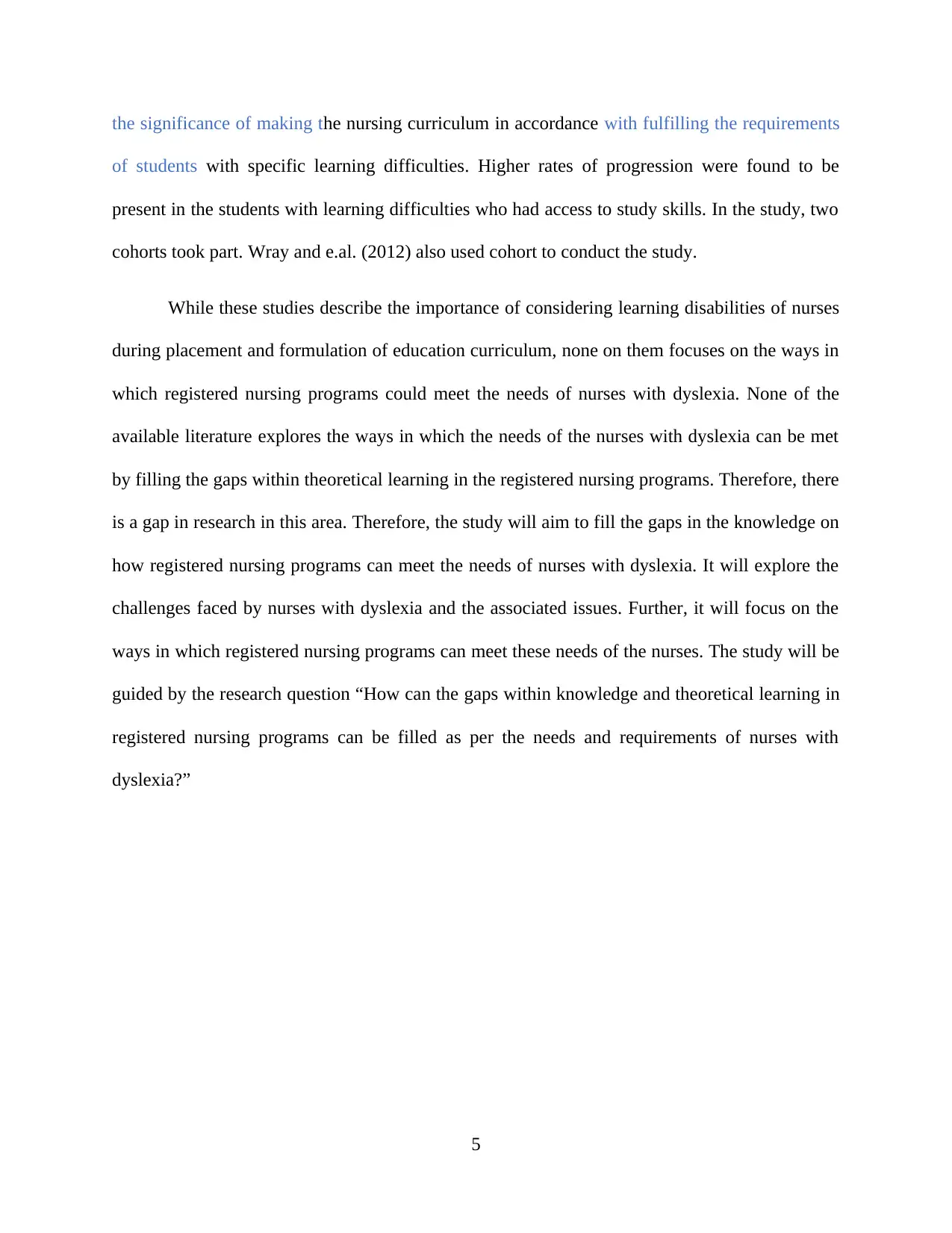
the significance of making the nursing curriculum in accordance with fulfilling the requirements
of students with specific learning difficulties. Higher rates of progression were found to be
present in the students with learning difficulties who had access to study skills. In the study, two
cohorts took part. Wray and e.al. (2012) also used cohort to conduct the study.
While these studies describe the importance of considering learning disabilities of nurses
during placement and formulation of education curriculum, none on them focuses on the ways in
which registered nursing programs could meet the needs of nurses with dyslexia. None of the
available literature explores the ways in which the needs of the nurses with dyslexia can be met
by filling the gaps within theoretical learning in the registered nursing programs. Therefore, there
is a gap in research in this area. Therefore, the study will aim to fill the gaps in the knowledge on
how registered nursing programs can meet the needs of nurses with dyslexia. It will explore the
challenges faced by nurses with dyslexia and the associated issues. Further, it will focus on the
ways in which registered nursing programs can meet these needs of the nurses. The study will be
guided by the research question “How can the gaps within knowledge and theoretical learning in
registered nursing programs can be filled as per the needs and requirements of nurses with
dyslexia?”
5
of students with specific learning difficulties. Higher rates of progression were found to be
present in the students with learning difficulties who had access to study skills. In the study, two
cohorts took part. Wray and e.al. (2012) also used cohort to conduct the study.
While these studies describe the importance of considering learning disabilities of nurses
during placement and formulation of education curriculum, none on them focuses on the ways in
which registered nursing programs could meet the needs of nurses with dyslexia. None of the
available literature explores the ways in which the needs of the nurses with dyslexia can be met
by filling the gaps within theoretical learning in the registered nursing programs. Therefore, there
is a gap in research in this area. Therefore, the study will aim to fill the gaps in the knowledge on
how registered nursing programs can meet the needs of nurses with dyslexia. It will explore the
challenges faced by nurses with dyslexia and the associated issues. Further, it will focus on the
ways in which registered nursing programs can meet these needs of the nurses. The study will be
guided by the research question “How can the gaps within knowledge and theoretical learning in
registered nursing programs can be filled as per the needs and requirements of nurses with
dyslexia?”
5
⊘ This is a preview!⊘
Do you want full access?
Subscribe today to unlock all pages.

Trusted by 1+ million students worldwide
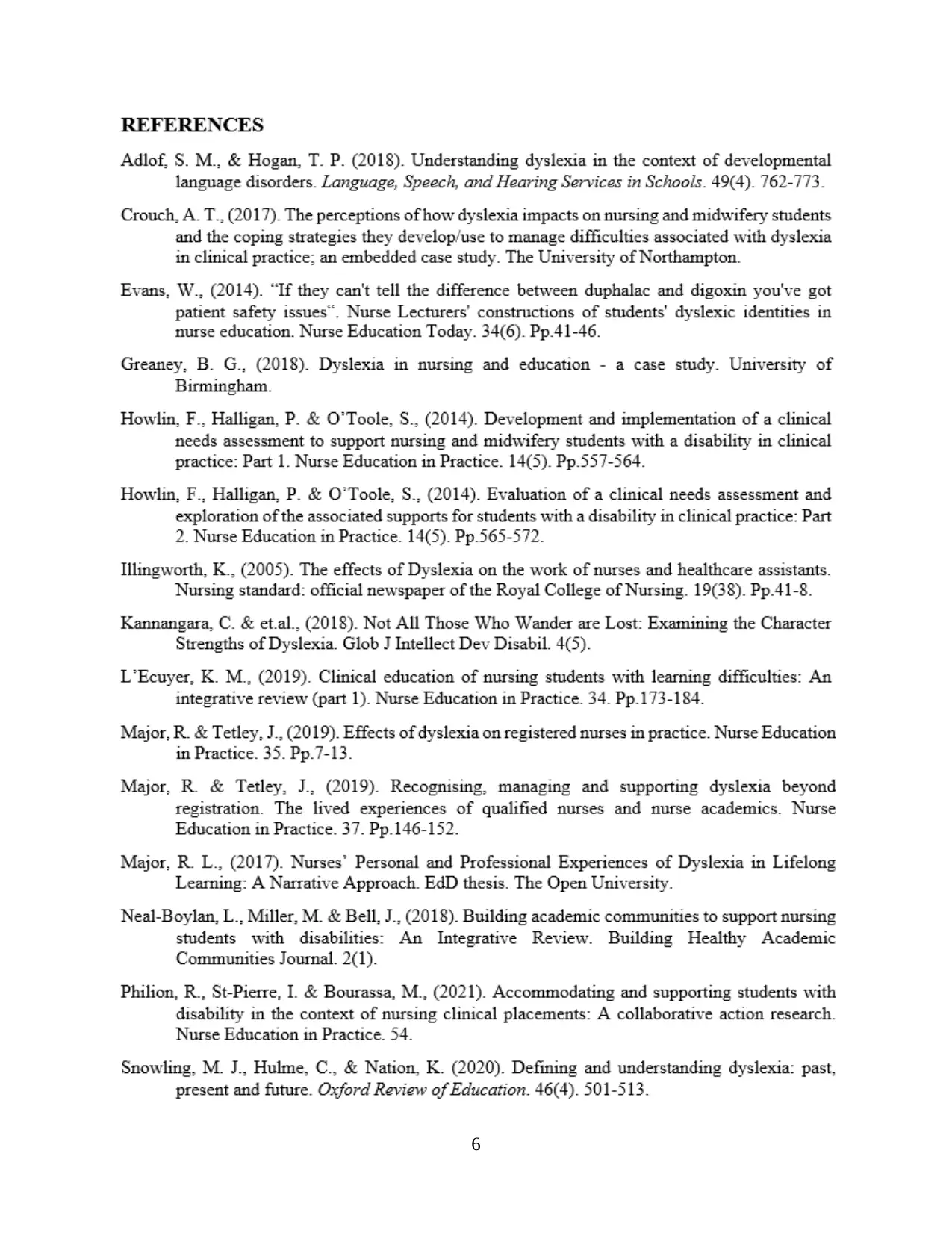
6
Paraphrase This Document
Need a fresh take? Get an instant paraphrase of this document with our AI Paraphraser
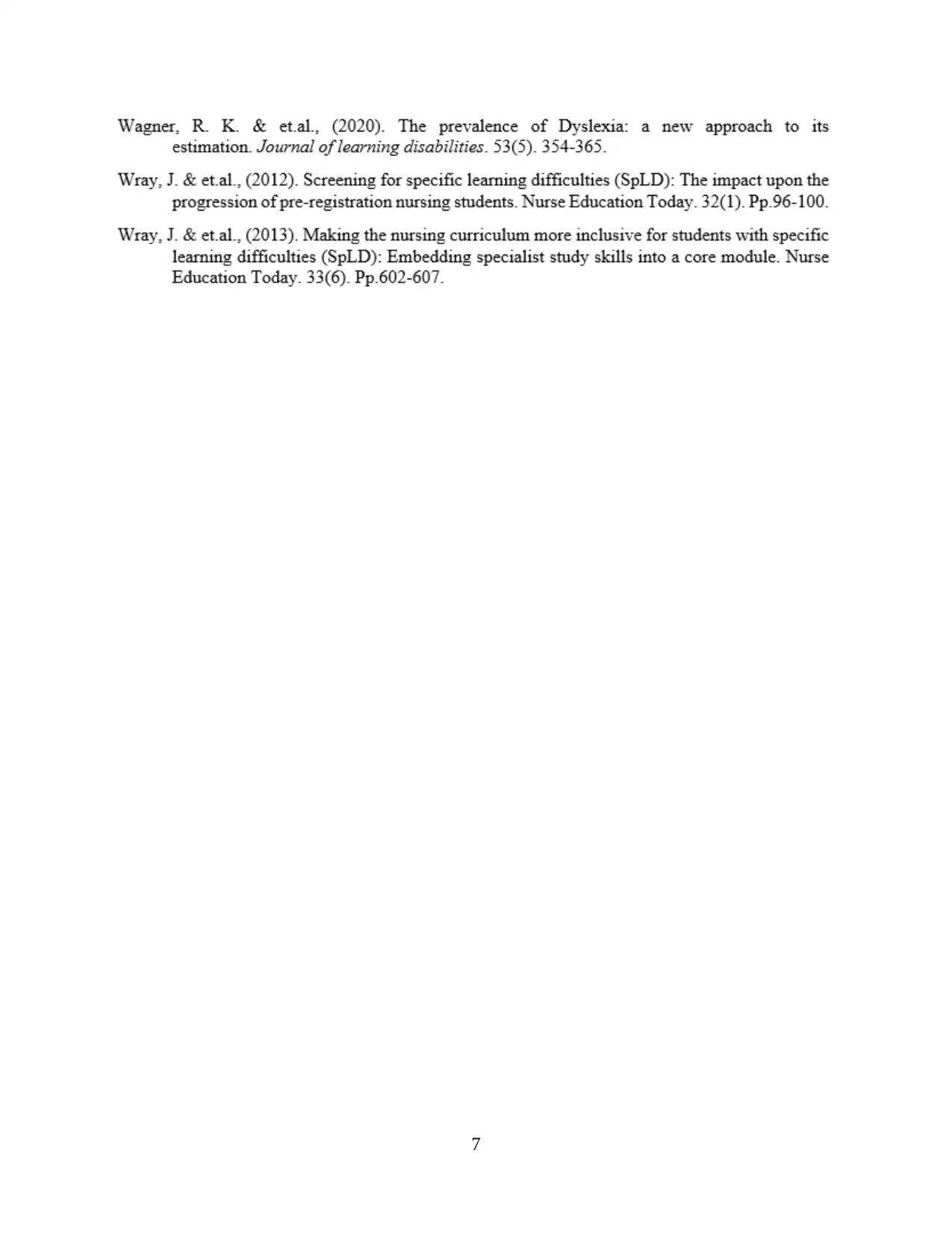
7
1 out of 8
Related Documents
Your All-in-One AI-Powered Toolkit for Academic Success.
+13062052269
info@desklib.com
Available 24*7 on WhatsApp / Email
![[object Object]](/_next/static/media/star-bottom.7253800d.svg)
Unlock your academic potential
Copyright © 2020–2025 A2Z Services. All Rights Reserved. Developed and managed by ZUCOL.





